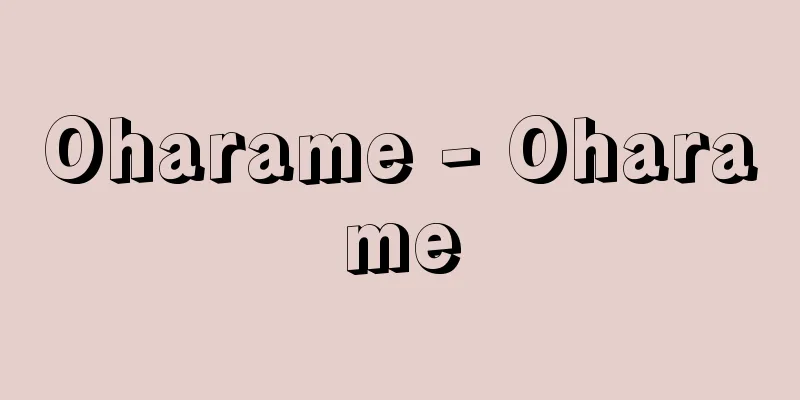Oshiki - Oshiki

|
A square wooden tray for placing tableware, cups, etc. It is surrounded by a border of narrow boards. Since the Heian period, it has been used for everyday meals and celebratory banquets, and there are many different types depending on the style, material, and decoration. There are various types of trays, such as "sumikiri" (corner-cut trays) with the four corners cut off, "flat" (square trays), "ashitsuki" (legged trays), and "ashiuchi" (footed trays), and the trays with legs are usually used for people of higher rank. Thinly shaved cypress boards are the norm, and cedar and Japanese horse chestnut are also used, but rosewood is used in "Ume no Hanagasa" (Plum Blossom Hat) in "Utsubo Monogatari," senko (a type of fragrant wood) in "Wakana" (Wakana) in "The Tale of Genji," and aloeswood in "Mustard Tree," and aloeswood is also mentioned in "The Diary of Murasaki Shikibu." White orishiki, which is made of plain wood and has white chalk applied all over it, blue orishiki with a blue border, and painted orishiki were used for celebrations. In the early modern period, lacquered orishiki with black lacquer, vermilion lacquer, blue lacquer, and urushi lacquer appeared. [Goka loyal retainer] Edo period (17th-18th century) Wood and lacquer 28.5 x 28.5 cm each Aichi Prefectural Museum of Art (Kimura Teizo Collection) Red lacquer square cut-out tray A meal for a high-ranking samurai in the Muromachi period. A large and small folding tray with legs (main and second trays) are lined up, along with a small folding tray (third tray) on the left. The main tray has five kinds of vegetables, rice and soup, while the second tray has three kinds of vegetables. The third tray also has two kinds of delicacies. A woman serving sake stands by in the room, holding a sake cup. "Sake and Meshi Ron" (A copy of the book is held by the National Diet Library ) Samurai meals as seen in "Sake and Meals" Source: Shogakukan Encyclopedia Nipponica About Encyclopedia Nipponica Information | Legend |
|
食器、杯などを載せる木製方形の盆。細い幅の板で囲って縁としている。平安時代から平常の食事、祝いの宴などに用いられ、形式、材質、加飾によっていろいろな種類がみられる。四隅を切った角切(すみきり)折敷、四角な平折敷、脚をつけた脚付、または足打(あしうち)折敷の形式があり、脚のついたほうを目上の人に用いるのが例である。材質は薄く削った檜(ひのき)板が常で、杉、椽(とち)も用いるが、『うつほ物語』「梅の花笠(はながさ)」に紫檀(したん)、『源氏物語』「若菜」に浅香(せんこう)(香木の一種)、「宿木」に沈香(じんこう)、『紫式部日記』でも沈香を用いたことを伝えている。白木を加飾して、全体に胡粉(ごふん)を施した白折敷、縁青の青折敷、画を描いた絵折敷は祝い事に用いられた。近世には黒漆、朱漆、青漆、溜塗りなどの塗折敷が現れた。 [郷家忠臣] 江戸時代(17~18世紀) 木・漆 各28.5×28.5cm愛知県美術館(木村定三コレクション)"> 朱漆角切折敷 室町時代の上級武士の食事。大小の脚付折敷(本膳、二の膳)と左に小さな折敷(三の膳)が並ぶ。本膳には5種の菜に飯と汁、二の膳には3種の菜がのっている。三の膳にも2種の馳走が置かれている。座敷には酒を給仕する女が、銚子を持って控えている。『酒飯論』 模写国立国会図書館所蔵"> 『酒飯論』にみる武士の食事 出典 小学館 日本大百科全書(ニッポニカ)日本大百科全書(ニッポニカ)について 情報 | 凡例 |
<<: Mimosa pudica - sensitive plant
Recommend
Poeciliidae
...Breeding and rearing in an aquarium is difficu...
Navy Admiral's Office - Kaigun Tei Tokufu
...An institution of the former navy that control...
Magnificent Frigatebird - American Frigatebird
...This is probably a primitive group of Pelecani...
The Outer Title of Relief - Andon no Gedai
...Later, during the Kagen era (beginning of the ...
Aedes (bush mosquito) - Aedes
In the narrow sense, it is a general term for inse...
Mukanfumon - Mukanfumon
A monk of the Rinzai sect of Buddhism, Shoichi sc...
Yaqui - Yaki (English spelling)
A Uto-Aztec-speaking indigenous people who live ma...
Straining
…There are many occasions in daily life when abdo...
Alternative gathering - Koutai yoriai
The occupations and family status of the Edo Shogu...
Davies, D.
…A painter from the period of the Pre-Raphaelite ...
Cryptobranchus alleghaniensis; hellbender
Order: Hynobiidae, Family: Hynobiidae. Appearance ...
uwepeker
…They range from short proverbs to long stories, ...
synovial bursa (English spelling)
…Therefore, in general, spindle muscles have a wi...
Empire style
A neoclassical decorative style in architecture, i...
Large water plantain - Large water plantain
...It is distributed in the temperate and subtrop...









